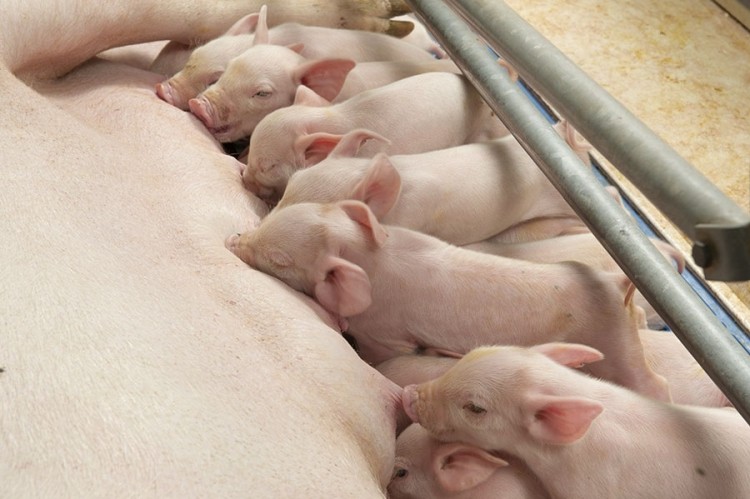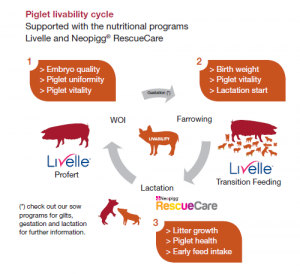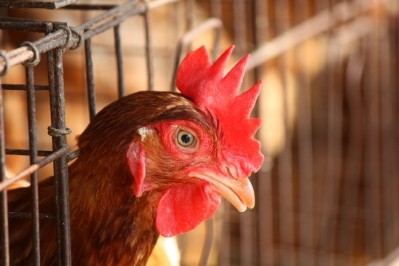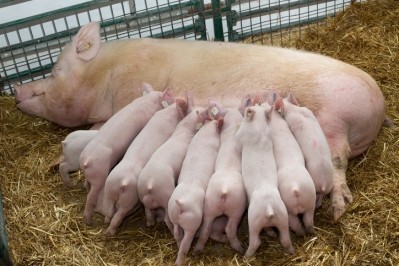Cargill tweaking sow diets to boost piglet livability

The past two years has seen its swine researcher target the weaning to estrus interval, and the transition period around parturition, stages pivotal in the breeding cycle in terms of the impact on piglet livability.
It said it has also adjusted its early piglet nutrition concept. “Essentially, in terms, of piglet feeding, as more and more farms of taken on our programs, we have modified hardware and formulations, to make them more robust,” said Cargill global swine technology leader, Marc Decoux.
Pig farms with highly prolific sow herds in the Netherlands, the Benelux, Germany, and Denmark, are currently using its piglet livability program.
“Those producers have already invested hugely in their farms, and they now want to bring their production to the next level; we are also seeing interest from pig farmers in Spain, Poland and the UK,” he told us.
Birth weight and uniformity
The evolution of genetic selection for hyperprolific sows has resulted in increased litter size, in some farms, up to 35 piglets per litter. However, this improvement has been accompanied by lower piglet livability, including higher early mortality and stillbirth.
Cargill’s ultimate aim is to increase piglet birth weight and litter uniformity. “The smaller the piglet the less chance it has enough energy reserves to cope,” said Decoux.
It has been looking at sow gestation in that context.
Some of the approaches taken include using Cargill’s own proprietary blend of polyphenols to boost the mother's oxidative defenses in the last stages before farrowing, he said. The Cargill experts have also been examining the transfer of antioxidants from the placenta to the piglet.
“In the past two years, we have learnt a huge amount about the influence of polyphenols on sow performance, and we have been particularly surprised at the impact they have on piglet birth weight. We have also gained a greater understanding into what is appropriate nutrition during the parturition period.”
Sows are under significant oxidative stress in the later gestation and lactation periods - feeding antioxidants like polyphenols helps sows maintain oxidative balance, and, consequently, enables better reproduction performance, explained Decoux.
In addition to their free radical scavenging function, it is known that polyphenols help with regeneration of vitamin E (Bouwnstra and Nwose, 2008), and have anti-inflammatory and antibacterial properties (Xi et al., 2011), he added.
Cargill has also been looking at ways to influence embryo development and uniformity of the litter in the five to six days after weaning, using a product that contains a high percentage of sugars and starch together with other components, to stimulate follicle and oocyte growth during that window.
Cargill’s Livelle Feeding Program
The company said use of Livelle Profert in sow diets from weaning to estrus has been shown to improve piglet birthweights by nearly 100g and to reduce the proportion of small piglets in a litter by 40%.
It said formulating sow diets following its Livelle transition concept, used around parturition, has also been shown to significantly increase piglet birthweight by 2.7% and piglet viability by 2.1%.
Its sow programs are complemented by an early piglet nutrition element - an automatic piglet liquid feeding system, set up to supply fresh liquid feed, 24/7, to piglets in the farrowing crate.
Research
EU and US research trials, carried out by Cargill in the past two years, have generated supporting data around supplementing sow diets with polyphenols, said Decoux.
The difference Cargill can bring in terms of research is in the size of the animal cohort it is able to test its nutritional products on, he said. “Statistical significance is what we are about, in terms of the number of sows enrolled in our trials and the control we have on them during the experiment. In addition, we can track results from gestation to lactation to the performance of the piglets in the nursery.”
Antioxidant trial
Cargill is to present new research into the influence of its product, Proviox - a blend of soluble polyphenols mainly coming from grape and onion with high antioxidant properties, by scavenging free radicals and terminating oxidative reactions - on piglet livability and performance post weaning during this week’s Animal Nutrition Research Forum in Ghent.
The talk will focus on a trial Cargill conducted at is sow innovation center in Kentucky, which included 540 breeding sows, said Decoux.
The aim of that experiment was to see if the polyphenol blend, when fed to the sow, might bring an improvement in piglet livability through an increased flow of nutrients and oxygen from the mother to the offspring through better placental efficiency, increased colostrum and milk quality, and the better ability of the sow and progeny to handle stressful situations.
Methods employed
Diets were corn-wheat based and met recommendations for gestating or lactating sows. Vitamin E was also added at recommended levels, and Proviox was used to partly replace the vitamin E, said the team.
In gestation, sows were fed 2.7 kg/d, after farrowing sows were fed lactation diet ad libitum.
Reproductive performance of the sows was recorded including number of piglets born alive, stillborn and mummified, as well as number of piglets weaned, they added.
Litter birth weight measurements were captured within 24h after birth. A total of 125 piglets born in this trial were ear tagged and their performance was measured from weaning (21 d of age) until 20 days post weaning (pw), said the researchers.
Results
The dietary inclusion of the antioxidants (AOX) during sow gestation and lactation did not significantly influence piglet livability. However, by including AOX in gestating diets, livability was numerically improved by 2%, found the team.
They hypothesized that AOX help animals cope better with stressful conditions. “It might be possible that in this trial, conditions around farrowing and lactation were not stressful enough to show significant effects on livability. Proviox provided during gestation on top of vitamin E tended to increase average piglet birth weight by 2%,” said the Cargill researchers.
They said the polyphenols present in the AOX used are thought to have a vasodilative effect, which leads to an increased placental blood flow, thereby delivering more oxygen and nutrients to the piglet: “The dietary inclusion of AOX on top of vitamin E during sow lactation significantly increased ADG of piglets from day 0-7 and day 7-20 pw. This is hypothesized to be caused by a better ability of these piglets to cope with weaning stress, due to an increased antioxidant status of the milk.”
The team noted a significant interaction between gestation and lactation treatment for ADG from day 0-20 pw. “This shows the effect of vitamin E equivalence in lactation is influenced by its level in gestation on piglet gain. Highest piglet performance was achieved when normal vitamin E equivalent (60 IU/kg) was provided in gestation, followed by 120 IU/kg vitamin E equivalent consisting of both vitamin E (60 IU/kg) and AOX (120 mg/kg).”
The researchers concluded the natural antioxidant blend tended to increase piglet birth weight and increased piglet performance when added to the diets of gestating and lactating sows, respectively.
Title: Feeding sows with natural antioxidants to improve piglet livability and performance
Authors: R. van Emous, M. van den Bosch, M. Hilbert, A. van Wesel, B. Humphrey, J. Zhao, S. Shaw

















